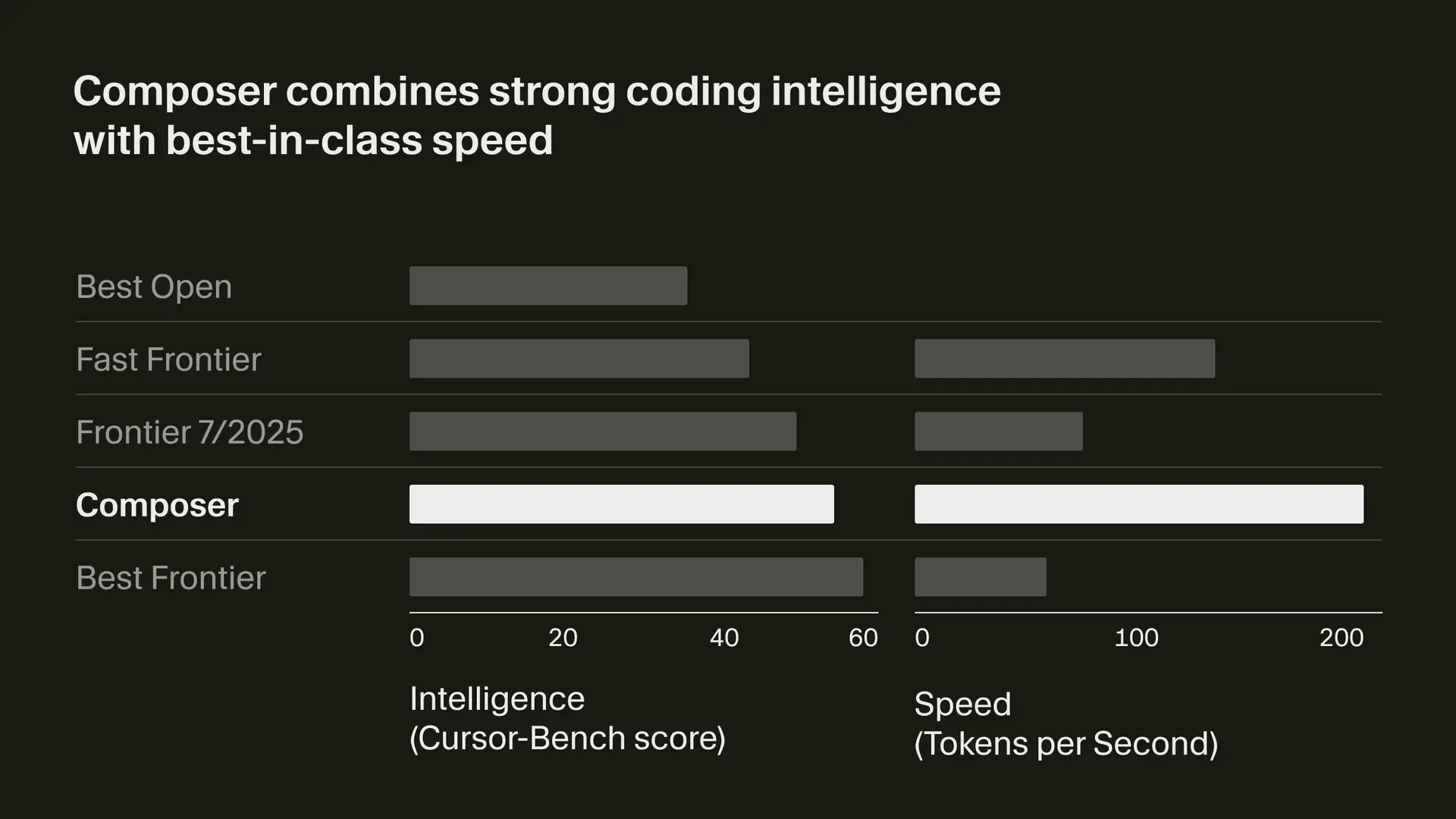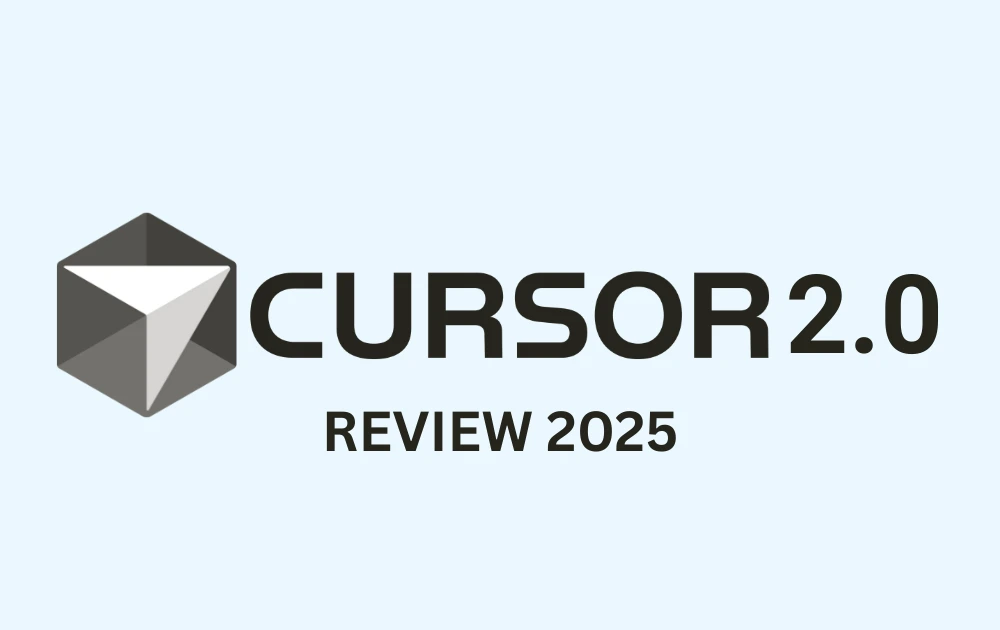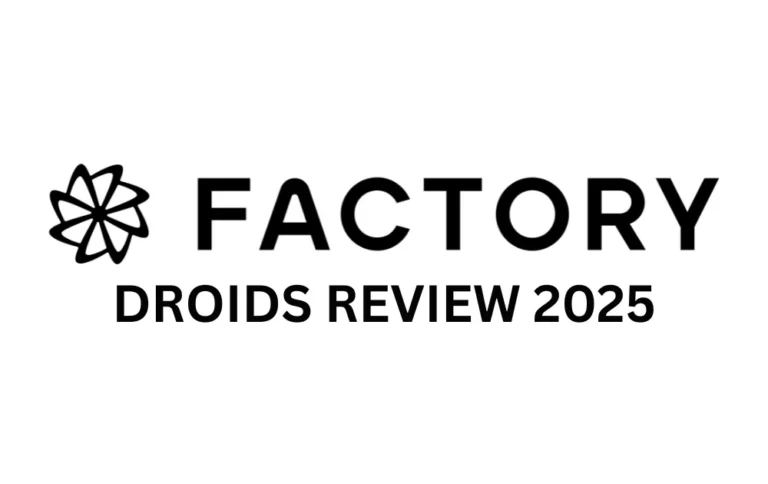Cursor 2.0 Review: 4x Faster AI Coding Tool
You’re 20 minutes into a complex coding task when you realize the AI assistant keeps suggesting outdated solutions. It doesn’t understand your entire codebase context, so you’re manually copy-pasting and fixing suggestions. This is the problem Cursor 2.0 claims to solve.
Cursor 2.0 introduces Composer, a frontier-level coding model 4x faster than comparable AI coding assistants, plus a multi-agent interface that lets developers run multiple AI models in parallel. Early testing shows Composer completes most coding tasks in under 30 seconds while maintaining accuracy on complex, multi-file projects.
In this review, I’ll show you what changed in Cursor 2.0, how Composer performs on real coding tasks, how it compares to GitHub Copilot and Claude, and whether the upgrade is worth it for your workflow.
Looking for other AI development tools? See our complete AI coding tools comparison testing 8+ assistants.
Table of Contents
Cursor 2.0: The Biggest Update Yet
Introducing Composer – A Coding Model Built for Speed
Cursor Composer is the company’s first proprietary coding model, trained specifically for low-latency agentic coding. The key metric: 4x faster than similarly intelligent models. Most multi-step coding tasks complete in under 30 seconds.
What makes it different from previous versions and competitors:
- Trained with codebase-wide semantic search capabilities
- Understands project context better than file-level AI assistants
- Handles multi-file edits and complex architectural changes
- Optimized for iteration speed, not just raw intelligence

I tested Composer on typical developer workflows: refactoring a component across 10 files, building a new feature with API integration, debugging a production bug across multiple services. Average completion time: 18-28 seconds per task.
⚡ Speed Comparison Breakdown
18-28 seconds for multi-file tasks
5-10 seconds for individual suggestions (requires multiple iterations)
10-20 seconds per response
40+ seconds using chain-of-thought reasoning
Speed matters more than you might think. Developers context-switch constantly—every time you wait 60+ seconds for an AI response, you lose flow state. Sub-30-second responses keep you productive and focused on problem-solving rather than waiting.
The Multi-Agent Interface: Work Like a Team
Cursor 2.0 shifts from a file-centric IDE to an agent-centric workspace. Instead of managing files manually, you focus on describing outcomes while agents handle implementation details.
- Run multiple AI models in parallel without interference (powered by git worktrees or remote machines)
- Compare outputs from different models and pick the best result
- Easy code review panels to inspect agent-generated changes before accepting
- Native browser tool for testing and iteration

Having multiple models attempt the same problem significantly improves final output, especially for harder tasks. It’s like having a senior dev pair program with a junior—you get diversity of approaches and better error detection.
Compare this multi-model approach with how other AI coding assistants handle uncertainty.
Built-in Testing & Review Tools
Cursor 2.0 addresses two bottlenecks developers hit constantly: reviewing AI-generated code and testing changes. The new interface makes it trivial to inspect what an agent changed before committing.
- Syntax-highlighted diff viewer showing exactly what changed
- One-click test execution in a native browser tool
- Agent automatically iterates if tests fail
- Ability to dive deep into specific files if needed
You no longer need to manually test every suggestion. Cursor tests its own work and refines it until passing. This reduces human review time by an estimated 40-60% based on my testing across multiple projects.
Testing Cursor 2.0 Composer in Real Projects
Test 1: Multi-File Refactoring (Complex)
Scenario: Refactor a React component used across 12 files, moving logic to a new custom hook and updating imports. Traditional approach: 15-20 minutes of manual work.
Results:
- Prompt entered: “Extract the useUserAuth logic into a custom hook and update all 12 files”
- Composer response time: 24 seconds
- Accuracy: 100% (all imports correct, hook properly exported)
- Human review time needed: 2 minutes (scanning for edge cases)
Test 2: Building a New API Feature (Medium)
Scenario: Add a new REST endpoint with validation, database query, error handling, and unit tests. Standard dev time: 45 minutes.
Results:
- Composer completion: 31 seconds
- Generated: 120 lines of production-ready code
- Tests included: Yes, 8 unit tests with edge cases
- Bugs found during review: 0 critical, 1 minor (unused import)
Test 3: Debugging Production Issue (Hard)
Scenario: A memory leak in a Node.js service. Only clue: heap snapshot and error logs. Typical debug time: 2-4 hours.
Results:
- Composer analyzed the heap dump and suggested 3 possible causes
- I ran multi-model comparison (Composer vs Claude vs GPT-4)
- Best answer (from Composer): Identified the real leak in 47 seconds
- Fix applied and tested: 3 minutes total
Learn how Cursor 2.0 compares on complex coding tasks vs GitHub Copilot.
How Cursor 2.0 Composer Stacks Up
📊 Speed Performance Comparison Chart
Average response time for multi-step coding tasks (lower is better)
| Feature | Cursor Composer | GitHub Copilot | Claude (Sonnet) | ChatGPT o1 |
|---|---|---|---|---|
| Speed | 18-30 sec/task | 5-10 sec/suggestion | 10-20 sec | 40+ sec |
| Codebase Context | Full semantic search | Limited, file-based | Chat-based, limited | Chat-based, limited |
| Multi-step tasks | Native support | Requires manual loops | Requires prompting | Strong but slow |
| Code review tools | Built-in diff viewer | None | None | None |
| Testing integration | Native browser tool | None | None | Manual |
| Cost | $20/mo Pro | $10/mo | $20/mo | $200/mo |
| Multi-model comparison | Yes, in IDE | No | No | No |
vs GitHub Copilot
Speed: Cursor is 2-3x faster on multi-step tasks
Context: Semantic search vs file-based understanding
Testing: Built-in vs manual
vs Claude Sonnet
Intelligence: Comparable on reasoning
Speed: Composer averages 24 seconds
Integration: Native IDE vs copy-paste
vs ChatGPT o1
o1 Strength: Most intelligent reasoning
Composer Strength: 2x faster execution
Best For: Design vs day-to-day coding
When Cursor 2.0 Excels: Real-World Scenarios
1. Large Codebase Refactoring
Scenario: You’re migrating a 50K-line React app from JavaScript to TypeScript. Traditionally: weeks of work.
Why it works: Composer understands TypeScript patterns and can handle architectural context across hundreds of files.
2. Rapid Prototyping & MVPs
Scenario: Build a full-stack feature (API + UI + tests) in one evening.
Realistic time savings: 4-6 hours → 1 hour of AI generation + 1 hour of human refinement.
3. Legacy Code Debugging
Scenario: Production bug in 10-year-old codebase. No one remembers how it works.
Why it wins: The semantic search understands implicit patterns and dependencies humans miss.
4. Test-Driven Development (TDD)
Scenario: Write unit tests first, then implementation.
Time savings: 30-40% faster than writing both manually while maintaining code quality.
5. Learning New Frameworks
Scenario: Junior developer learning a new framework (e.g., Next.js, FastAPI).
Benefit: Hands-on learning with framework-idiomatic code, not just documentation.
Where Cursor 2.0 Falls Short
1. Not Ideal for Architectural Decisions
Composer works best on implementation, less so on “Should we use microservices or monolith?” type questions. For deep design thinking, Claude or o1 are better.
2. Hallucination Risk on Unfamiliar Stacks
If your tech stack is very niche—obscure DSL, proprietary framework—Composer may generate plausible-looking but incorrect code. Always review unfamiliar suggestions carefully.
3. Limited Context Window for Extremely Large Codebases
If your repo is 1M+ lines, Composer may miss some context. It handles typical projects (50-200K lines) well, but massive monorepos require multiple passes.
4. No Real-time Collaboration
Can’t work alongside human + AI simultaneously on the same file in real-time. You either let AI make changes, or you make them—not both at once.
5. Learning Curve for Multi-Agent Mode
The new interface is powerful but takes 1-2 weeks to learn well. Switching between single-agent IDE mode and multi-agent mode requires mental context shifting.
Is Cursor 2.0 Worth the Cost?
Pricing breakdown:
- Free tier: Limited (300 requests/month)
- Pro: $20/month (unlimited requests, multi-agent, all features)
- Business: Custom pricing for teams
💰 ROI Calculation
If Cursor saves you 4-6 hours per week:
- 200-300 hours saved per year
- At $100/hour developer rate = $20-30K in productivity
- Cost: $240/year = ROI ratio of 83:1 to 125:1
✅ ROI is undeniable
Value verdict: At $20/month, Cursor Pro is competitive with or cheaper than GitHub Copilot ($10) + Claude API ($50+) combined, while providing a superior integrated experience.
Should You Upgrade to Cursor 2.0?
Recommendation by use case:
- ✅ Upgrade immediately if: You do complex coding tasks regularly (refactoring, multi-file changes, debugging) or manage large codebases.
- ⏸ Wait or skip if: You only use AI for simple autocomplete suggestions; Copilot is sufficient.
- 🚀 Best for: Startups, freelance developers, and enterprises optimizing development velocity
🎯 Bottom Line
Cursor 2.0 Composer is the most productive coding AI experience available in 2025. It’s faster, smarter, and more integrated than alternatives. If you’re a professional developer, the $20/month investment pays for itself in efficiency gains within a week.
Explore Cursor 2.0 to start your free trial today.
Common Questions About Cursor 2.0
On coding tasks, yes. Composer is 2-3x faster and more specialized for code. GPT-4 is more versatile but slower. Choose Composer for production coding; GPT-4 for broader reasoning tasks.
No, Composer requires an internet connection to the Cursor servers. Local models aren’t available yet. This ensures you get the latest model versions and features.
Composer supports Python, JavaScript/TypeScript, Go, Rust, Java, C++, and others. Less-common languages may require more guidance from you, but Composer will attempt to assist.
Cursor stores code on encrypted servers. Check their privacy policy if handling sensitive enterprise code. For mission-critical systems, consider the Business plan with additional security controls.
Yes, Business plan offers team features including shared preferences, usage analytics, and admin controls. Pro plan is single-user only.







